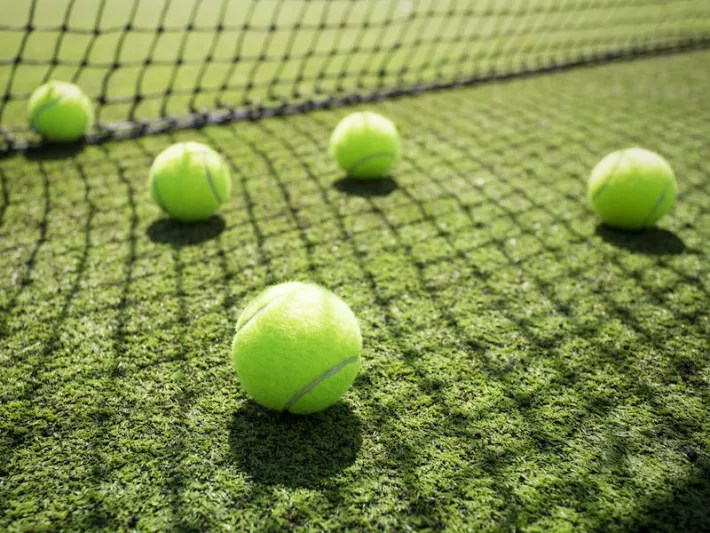The first Wimbledon championships were held in 1877. They featured a field of 22 men, who were advised to bring their own racquets and to wear “shoes without heels.” The balls were hand-sewn, with a flannel casing. The racquets were made of wood and looked distinctly like snowshoes.
The event was so successful that a women’s championship was added seven years later. First prize for the ladies was a silver flower basket, valued at 20 guineas.
Fast forward about a hundred years. In 2018, the winner of the women’s tournament, Angelique Kerber, took home 2.25 million pounds (that’s about 2.8 million US dollars). Her racquet was made of a carbon-graphite compound originally developed for use in space flight. And the balls she played with had to match international standards dictating their mass, size, deformation, and rebound.
In other words, things have changed.
One thing that hasn’t changed though is the weird scoring system used in tennis.
'Love' Means 'Zero' Because … Eggs?
Let’s start with “love” — the word that means “zero” in tennis.
When a match starts, the score is zero-zero; in the tennis world, that’s called “love all.”
There are a couple of theories on why. One is that the number zero has an oval shape, just like an egg. The French word for “egg” is “l’oeuf.” Say “l’oeuf” five times fast, and it starts to sound like “love.” L’oeuf, l’oeuf, l’oeuf, l’oeuf, l’oeuf.
Seems like a bit of a stretch, until you consider the fact that we also call “zero” on a scoreboard a “goose egg.” Sports fans have been saying this since at least 1867 … about the time the first tennis matches were being played.
'Love' Means 'Zero' Because … the Love of the Game?
Another theory is related to the expression “to play a sport for love,” as opposed to playing for money. This refers to the practice of playing a competitive game simply for the fun of it, not because you might win a prize.
In other words, just for the love of the game, you’d accept a score of love, and keep on playing.
This explanation is suggested but not verified by the Oxford English Dictionary. The OED also notes that “love” has been used for centuries to mean “zero” in other games, such as bridge and whist, the card game from which bridge is derived.
15, 30, 40 … What?
So in tennis, “love” means “zero.” What’s also odd is that instead of counting points as 1, 2, 3, and 4, in tennis, you count them as 15, 30, 40, and game. In other words, winning a fourth point wins you the game (provided you’ve won by two points).
So why does tennis do this?
It’s because tennis is based on a much earlier game known as “jeu de paume,” meaning “game of palms.” It got this name because players used their hands, rather than racquets, to bat a ball back and forth.
In this game, courts were 90 feet long, with 45 feet on either side of the net. When a player won a point, they got to move up 15 feet, and start the next point from there. If they won another point, they could move up another 15 feet. But if they won a third point, they couldn’t move up 15 more feet, or they’d be sitting right on top of the net. So, this theory goes, they would move up another 10 feet. Thus, their progression forward would be to 15 feet, then 30 feet, then 40 feet— which corresponds to the 15-30-40 scoring method we use in tennis today.
The second theory is that tennis’s scoring system is based on the movement of hands around a clock, with the quarter hours—15, 30, and 45—being progress points in winning the game.
This theory is a little shaky because the third point in a tennis game isn’t called 45. It’s called 40. But, this theory goes, maybe it took too long for players to say “45,” so over time, it was shortened to “40.”
Once again, this seems like a bit of stretch. However, consider the fact that amateur tennis players often shorten “15” to “five” when calling out their scores, purely because it’s easier to say. So it’s not unreasonable that the same thing happened with “45”; it was eventually shortened to “40.”
Tennis Was Almost Called 'Sphairistiké'
As strange as tennis scoring is, at least the sport didn’t retain the very strange name it was almost given: “sphairistiké.” That’s what the originator of modern tennis, one Major Walter Clopton Wingfield, called it back in 1873. And why not? In Greek, “sphairistiké” means “skill in playing at ball.”
The Major’s friends loved his game but suggested a simpler name: “lawn tennis.” And fortunately, that’s the name that has stuck around until today.
Samantha Enslen runs Dragonfly Editorial. You can find her at dragonflyeditorial.com or on Twitter as @DragonflyEdit.
Sources
BBC. Anyone for Sphairistiké? April 18, 2012.
Conradt, Stacy. Where did tennis get its scoring system? Mental Floss, Sept. 10, 2013.
International Tennis Federation. Approval Tests, tennis balls.
Miller, Stuart. Which Tennis Ball is in Use? It Makes a Difference. New York Times, Sept. 3, 2016.
Tennis Channel. “Tennis or sphairistike?” Posted via Twitter December 12, 2017.
Tennis Express. Yonex VCore 100 Galaxy Black Tennis Racquet.
The Championships at Wimbledon. About Wimbledon.
Encyclopedia Britannica, online edition. Goose egg, Tennis, Real tennis.
Oxford English Dictionary, online edition. Love, Tennis, Sphairistike. Oxford University Press.
Image courtesy of Shutterstock.




